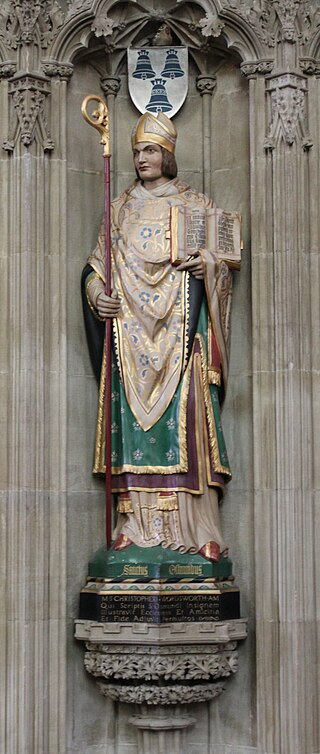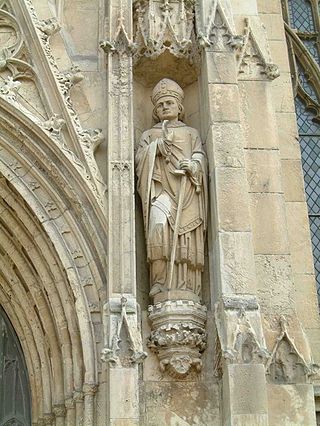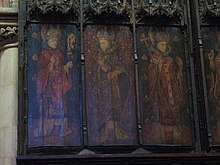
Aldhelm, Abbot of Malmesbury Abbey, Bishop of Sherborne, and a writer and scholar of Latin poetry, was born before the middle of the 7th century. He is said to have been the son of Kenten, who was of the royal house of Wessex. He was certainly not, as his early biographer Faritius asserts, the brother of King Ine. After his death he was venerated as a saint, his feast day being the day of his death, 25 May.

Richard Poore or Poor was a medieval English bishop best known for his role in the establishment of Salisbury Cathedral and the City of Salisbury, moved from the nearby fortress of Old Sarum. He served as Bishop of Chichester, Bishop of Salisbury and Bishop of Durham.

Osmund, Count of Sées, was a Norman noble and clergyman. Following the Norman conquest of England, he served as Lord Chancellor and as the second bishop of Salisbury, or Old Sarum.

Ernulf was a French Benedictine monk who became prior of Christ Church in Canterbury, abbot of Peterborough, and bishop of Rochester in England. A jurist and an architect as well, he was responsible for greatly expanding Canterbury Cathedral during his time there.

John of Beverley was an English bishop active in the kingdom of Northumbria. He was the bishop of Hexham and then the bishop of York, which was the most important religious designation in the area. He went on to found the town of Beverley by building the first structure there, a monastery. John was associated with miracles during and after his lifetime and was canonised a saint by the Catholic Church in 1037. As this is prior to the Great East–West Schism of 1054, he is also recognised as a saint by the Eastern Orthodox Church.
Jænberht was a medieval monk, and later the abbot, of St Augustine's Abbey, Canterbury, who was named Archbishop of Canterbury in 765. As archbishop, he had a difficult relationship with King Offa of Mercia, who at one point confiscated lands from the archbishopric. By 787, some of the bishoprics under Canterbury's supervision were transferred to the control of the newly created Archbishopric of Lichfield, although it is not clear if Jænberht ever recognised its legitimacy. Besides the issue with Lichfield, Jænberht also presided over church councils in England. He died in 792 and was considered a saint after his death.
Finan of Lindisfarne, also known as Saint Finan, was an Irish monk, trained at Iona Abbey in Scotland, who became the second bishop of Lindisfarne from 651 until 661.
Tuda of Lindisfarne, also known as Saint Tuda, was appointed to succeed Colman as Bishop of Lindisfarne. He served for less than a year. Although raised in Ireland, he was a staunch supporter of Roman practices, being tonsured in the Roman manner and celebrating Easter according to the Roman Computus. However, he was consecrated as bishop in Ireland.

Eata, also known as Eata of Lindisfarne, was Bishop of Hexham from 678 until 681, and of then Bishop of Lindisfarne from before 681 until 685. He then was translated back to Hexham where he served until his death in 685 or 686. He was the first native of Northumbria to occupy the bishopric of Lindisfarne.
Eadberht of Lindisfarne, also known as Saint Eadberht, was Bishop of Lindisfarne, England, from 688 until his death on 6 May 698.

Eadfrith of Lindisfarne, also known as Saint Eadfrith, was Bishop of Lindisfarne, probably from 698 onwards. By the twelfth century it was believed that Eadfrith succeeded Eadberht and nothing in the surviving records contradicts this belief. Lindisfarne was among the main religious sites of the kingdom of Northumbria in the early eighth century, the resting place of Saints Aidan and Cuthbert. He is venerated as a Saint in the Roman Catholic Church, and in the Eastern Orthodox Church, as also in the Anglican Communion.
Trumbert was a monk of Jarrow, a disciple of Chad and later Bishop of Hexham.

Acca of Hexham was an early medieval Northumbrian prelate, serving as bishop of Hexham from 709 until 732, and subsequently commemorated as a Christian saint.
Ælfwold II was a Bishop of Sherborne in Dorset. He is venerated as a saint in the Catholic Church.

The Bishop of Hexham was an episcopal title which took its name after the market town of Hexham in Northumberland, England. The title was first used by the Anglo-Saxons in the 7th and 9th centuries, and then by the Roman Catholic Church since the 19th century.
Saint Ceolwulf was King of Northumbria from 729 until 737, except for a short period in 731 or 732 when he was briefly deposed and then restored to power. Ceolwulf ultimately abdicated and entered the monastery at Lindisfarne. He was the "most glorious king" to whom Bede dedicated his Historia ecclesiastica gentis Anglorum.
Ælfheah the Bald is the commonly used name for Ælfheah, the first English Bishop of Winchester of that name. He is sometimes known as Alphege, an older translation of his Old English name.

Frithubeorht was an eighth-century medieval Bishop of Hexham.
Tilbeorht was a medieval Bishop of Hexham.
Alfred, son of Westou was a medieval English priest and relic collector, active in Northumberland. He is now best known for allegedly stealing the remains of Bede and bringing them in secret to the shrine of St Cuthbert in Durham, although some modern scholars consider this unlikely. He is also documented as having translated the remains of Boisil of Melrose Abbey, as well as numerous northern English minor saints of the 7th and 8th centuries: the anchorites Balther and Bilfrid; Acca, Alchmund and Eata, bishops of Hexham; Oswin, king of Deira; and the abbesses Ebba and Æthelgitha. He served as the sacristan at Cuthbert's shrine under three bishops, and was renowned for his devotion to the saint.










